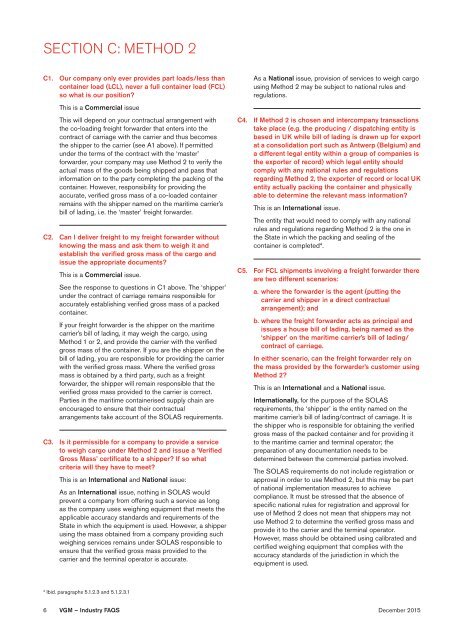Create successful ePaper yourself
Turn your PDF publications into a flip-book with our unique Google optimized e-Paper software.
SECTION C: METHOD 2<br />
C1. Our company only ever provides part loads/less than<br />
container load (LCL), never a full container load (FCL)<br />
so what is our position?<br />
This is a Commercial issue<br />
This will depend on your contractual arrangement with<br />
the co-loading freight forwarder that enters into the<br />
contract of carriage with the carrier and thus becomes<br />
the shipper to the carrier (see A1 above). If permitted<br />
under the terms of the contract with the ‘master’<br />
forwarder, your company may use method 2 to verify the<br />
actual mass of the goods being shipped and pass that<br />
information on to the party completing the packing of the<br />
container. However, responsibility for providing the<br />
accurate, verified gross mass of a co-loaded container<br />
remains with the shipper named on the maritime carrier’s<br />
bill of lading, i.e. the ‘master’ freight forwarder.<br />
C2. Can I deliver freight to my freight forwarder without<br />
knowing the mass and ask them to weigh it and<br />
establish the verified gross mass of the cargo and<br />
issue the appropriate documents?<br />
This is a Commercial issue.<br />
See the response to questions in c1 above. The ‘shipper’<br />
under the contract of carriage remains responsible for<br />
accurately establishing verified gross mass of a packed<br />
container.<br />
If your freight forwarder is the shipper on the maritime<br />
carrier’s bill of lading, it may weigh the cargo, using<br />
method 1 or 2, and provide the carrier with the verified<br />
gross mass of the container. If you are the shipper on the<br />
bill of lading, you are responsible for providing the carrier<br />
with the verified gross mass. Where the verified gross<br />
mass is obtained by a third party, such as a freight<br />
forwarder, the shipper will remain responsible that the<br />
verified gross mass provided to the carrier is correct.<br />
Parties in the maritime containerised supply chain are<br />
encouraged to ensure that their contractual<br />
arrangements take account of the SOLAS requirements.<br />
C3. Is it permissible for a company to provide a service<br />
to weigh cargo under Method 2 and issue a ‘Verified<br />
Gross Mass’ certificate to a shipper? If so what<br />
criteria will they have to meet?<br />
This is an International and National issue:<br />
As an International issue, nothing in SOLAS would<br />
prevent a company from offering such a service as long<br />
as the company uses weighing equipment that meets the<br />
applicable accuracy standards and requirements of the<br />
State in which the equipment is used. However, a shipper<br />
using the mass obtained from a company providing such<br />
weighing services remains under SOLAS responsible to<br />
ensure that the verified gross mass provided to the<br />
carrier and the terminal operator is accurate.<br />
As a National issue, provision of services to weigh cargo<br />
using method 2 may be subject to national rules and<br />
regulations.<br />
C4. If Method 2 is chosen and intercompany transactions<br />
take place (e.g. the producing / dispatching entity is<br />
based in UK while bill of lading is drawn up for export<br />
at a consolidation port such as Antwerp (Belgium) and<br />
a different legal entity within a group of companies is<br />
the exporter of record) which legal entity should<br />
comply with any national rules and regulations<br />
regarding Method 2, the exporter of record or local UK<br />
entity actually packing the container and physically<br />
able to determine the relevant mass information?<br />
This is an International issue.<br />
The entity that would need to comply with any national<br />
rules and regulations regarding method 2 is the one in<br />
the State in which the packing and sealing of the<br />
container is completed 4 .<br />
C5. For FCL shipments involving a freight forwarder there<br />
are two different scenarios:<br />
a. where the forwarder is the agent (putting the<br />
carrier and shipper in a direct contractual<br />
arrangement); and<br />
b. where the freight forwarder acts as principal and<br />
issues a house bill of lading, being named as the<br />
‘shipper’ on the maritime carrier’s bill of lading/<br />
contract of carriage.<br />
In either scenario, can the freight forwarder rely on<br />
the mass provided by the forwarder’s customer using<br />
Method 2?<br />
This is an International and a National issue.<br />
Internationally, for the purpose of the SOLAS<br />
requirements, the ‘shipper’ is the entity named on the<br />
maritime carrier’s bill of lading/contract of carriage. It is<br />
the shipper who is responsible for obtaining the verified<br />
gross mass of the packed container and for providing it<br />
to the maritime carrier and terminal operator; the<br />
preparation of any documentation needs to be<br />
determined between the commercial parties involved.<br />
The SOLAS requirements do not include registration or<br />
approval in order to use method 2, but this may be part<br />
of national implementation measures to achieve<br />
compliance. It must be stressed that the absence of<br />
specific national rules for registration and approval for<br />
use of method 2 does not mean that shippers may not<br />
use method 2 to determine the verified gross mass and<br />
provide it to the carrier and the terminal operator.<br />
However, mass should be obtained using calibrated and<br />
certified weighing equipment that complies with the<br />
accuracy standards of the jurisdiction in which the<br />
equipment is used.<br />
4<br />
Ibid. paragraphs 5.1.2.3 and 5.1.2.3.1<br />
6 VGM – Industry <strong>FAQS</strong> December 2015


